It’s becoming increasingly difficult to remember a time when the prospect of a film centered around the character of Thor seemed like the potential undoing of Marvel Studios. The Iron Man sequel had disappointed as had both Hulk films. Now, they were jumping into the realm of fantasy, and asking audiences to buy into a universe in which Norse mythology is real meaning places with names like Jutenheim and Asgard and gods like Thor, Odin, and Loki actually exist. They cast a complete unknown (Chris Hemsworth) as their star, and hired Kenneth Branagh as their director. More known as an actor, 6 of Branagh’s 10 directing credits to that point were Shakespeare adaptations (Henry V, Much Ado About Nothing, A Midwinter’s Tale, Hamlet, Love Labour’s Lost, As You Like It). Pretty much nothing he had done made him an immediately obvious choice to direct a big-budget, special effects-heavy summer blockbuster action film.
It turns out Branagh was the perfect choice. The curiosity of his involvement in the project attracted higher-profile actors than would have normally taken part, such as Natalie Portman and Anthony Hopkins. Plus, to make a film about Thor work you needed a director who could focus upon making the characters relatable. He crucially set half of the film on modern day Earth where an audience surrogate character like Dr. Selvig (Skarskgard) could give voice to many cynical viewers in proclaiming, “This is all completely crazy!” Moreover, he maximized the emotional stakes of a Shakespearean tale of a king (Odin) and his two sons (Thor and Loki). By the end, when Thor sacrifices himself and thereby re-earns his right to wield his magic hammer (is there any way that didn’t sound at least a little dirty?) the audience is witnessing a man born with superhuman powers who has only at just that moment become a superhero. Moreover, when Loki pleads with Odin (“I could have done it, father. I could have done it. For you! For all of us!”) before falling into oblivion the audience has been made as sympathetic if not more so for the villain than the hero.
So, in celebration of Thor let’s look to Kenneth Branagh’s DVD/Blu-Ray commentary for any interesting bits of insight we might have missed before now:
1. Odin’s Strip of Thor Was Inspired by The Life of Emile Zola
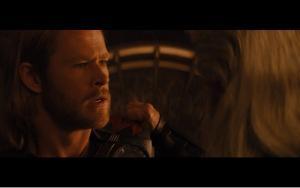
Immediately prior to being banished to Earth, Thor has one of the chest plates on his armor as well as part of his cape symbolically ripped off by Odin. Of course, it ultimately matters not as Odin’s magic completely strips Thor of his entire costume via some CGI wizardry as he is being sucked into the bifrost as part of the banishment. However, Branagh’s motivation was to treat it like a military court martial. In that way, the imagery of Odin ripping off portions of Thor’s costume was directly inspired by a court martial scene involving a soldier having the epaulettes ripped off of his uniform at the end of his trial in The Life of Emile Zola (which Branagh erroneously refers to as being titled The Dreyfus Affair).
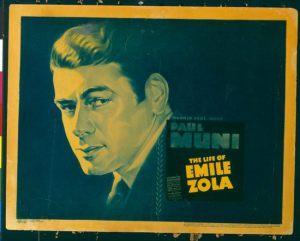
The Best Picture winner of 1937, Emile Zola is the most notable cinematic depiction of the historical Dreyfus Affair, a scandal in the French government in the late 19th century involving the unjust court martial of an innocent Jewish soldier named Alfred Dreyfus. A famous French author of the time named Emile Zola published a letter entitled J’Accuse (translation: I Accuse) in which he presented damning evidence against the government. This directly lead to Dreyfus’ acquittal, though not before Zola had been found guilty of libel and sentenced to a year in prison.
2. Jaimie Alexander – Gorgeous, Tough, and She Likes Comic Books
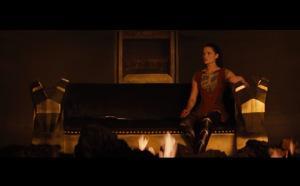
Jaimie Alexander is a stunningly gorgeous woman who some might be crestfallen to discover is not actually British, despite her accent as the warrior Sif in the Thor films. Nope, she grew up in Texas. Branagh observes that she grew up with multiple brothers which has made her somewhat of a tomboy. A byproduct of this is that she is, by Branagh’s assessment, a humongous comic book nerd. He states that she probably knew about the comics than almost everyone working on Thor, meaning any hint you might see of Alexander’s Sif having feelings for Thor is completely intentional since Sif is his eventual wife in the comics. Of course, since the release of Thor anyone who has ever read/hear/seen Alexander interviewed already knows about her comic book expertise, which has taken on a high profile as of late in relation to Wonder Woman.
3. The King Arthur/Excalibur to Thor/Mjolnir Comparisons Are Not Lost on Branagh
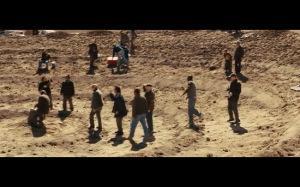
One of the funnier moments in the film involves the townspeople of a small New Mexico town gathering to each try and lift Thor’s hammer, ending with a fun Stan Lee cameo as the driver of a truck who foolishly attempted to simply haul the hammer out of the ground. This sequence was inspired by various similar moments from the comics. However, Branagh is quick to point out that the comics clearly got their idea from Arthurian legend. King Arthur became the divinely appointed king due to his possession of the sword Excalibur, which only the most worthy person could pull from the stone in which it was lodged. So, just replace Arthur with Thor and Excalibur with Mjolnir.
4. There Actually Was a Point to Having Hemsworth Be Shirtless…Not That We Really Care Because Look at All The Muscles
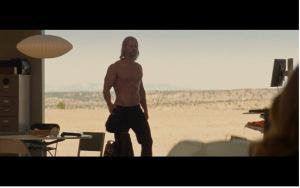
You could argue that Thor’s brief shirtless scene is unnecessary, as much an objectification of a male actor (Chris Hemsworth) as many other films are accused of doing with female actors. Or you could just laugh away such noise and get lost in admiration, lust, or both at the sight of the product of Hemsworth’s 6-9 months of intense physical training. However, there is an actual purpose to the moment. Branagh puts it succinctly, “We needed Thor to look like a god, and Chris Hemsworth did.” Hemsworth apparently was so okay with going shirtless he practically insisted upon it (otherwise what was all that physical training for). Well, God bless his muscle-bound torso.
5. That New Mexico Town? They Just Built That
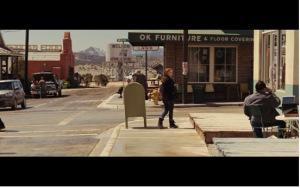
The sign on the water tower in the background reads “Home of the Vikings”
The small New Mexico town was actually in New Mexico, located just outside of Sante Fe. It wasn’t a real town, though. Instead, it was a location used in the filming of countless westerns, “as far back as Silverado and as recently as Appaloosa.” The Thor production team built upon this existing framework, but ultimately basically built their own entire little town (Iron Man 3 did something similar in a North Carolina town). This was done to allow them to control as many elements as possible, such as not needing to stop traffic. Plus, this allowed them more freedom to plan the logistics of the final sequence with The Destroyer during which parts of the town are demolished. Branagh explains the decision to set the Earth stuff in a New Mexico town in the first place was inspired by experiences Branagh had in that region of the country. His concept was for it to be a town smack dab in the middle of the vast sea of the desert just like Asgard sits in the vast sea of space.
6. The Dutch Angles Were Directly Inspired By the Comics
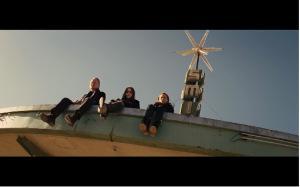
An example of a dutch angle in Thor
To some it might go unnoticed, but Thor is a film which has plenty of dutch angles, i.e., the term used to describe tilted camera angles. Such angles are incredibly common in comic book movies, and are often a source of critical disdain due to overuse. Branagh addresses this, arguing that such angles are how he remembered the frames from the comic books. Beyond that, he says, “They were there because that’s how I received the dynamism of the composition in the frames, wide angle lenses with lots of depth. That’s why I chose that type of style for this.”
7. Thursday is Thor’s Day
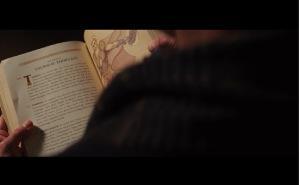
There is actually a very quick Etymology lesson in the film. When Dr. Selvig picks up the children’s book about Norse mythology one of the pages he looks at has an image which reads “Thursday-Thor’s Day.” Branagh says he “wanted to have in the movie from day 1 which is the simple explanation that Thursday comes from Thor, it is Thor’s day, as indeed Friday comes from Frigga (Thor’s mother) and two other days from the western calender that are also influenced by the Norse myth.” He’s right – both Thursday and Friday are words which are derived from Old English references to Thor and Frigga. The other days whose names are similarly indebted to Norse mythology include Monday (“Moon’s Day,” the Norse god Mani being the moon personified), Tuesday (“Tiw’s Day”, Tiw being the Norse god of war) and Wednesday (“Woden’s Day,” Woden being the original name for Odin).
8. The Balance Between Earth and Asgard Was an On-Going Challenge
Maintaining the balance between the Earth and Asgard scenes was tricky. Many still argue they really like the movie, but not until it gets to Earth meaning the first 30 minutes are kind of lost on them. Speaking about the balance between the two realms, Branagh states, “Throughout draft after draft and in post-production, finding this rhythm was very crucial. Kevin Feige, our producer, always had good instincts about when we could or shouldn’t go to Earth or back to Asgard. What were the ways to exploit that rhythm, not confuse the audience. We knew probably there would be people who preferred being on Earth, some who preferred being on Asgard. We wanted both because we felt the story needed to interwine.”
9. Loki As Iago From Othello?
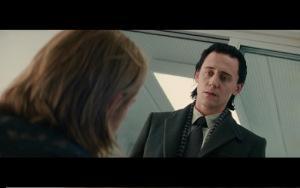
Of course, Shakespeare would come up at least once. Branagh makes an interesting comparison when discussing Loki’s deception of Thor on Earth, ”The act, if you like, of Loki is seamlessly done by Tom Hiddleston who evoked as by way of a model for his character the character of Iago in Othello, a terrifying Shakespearean character who is a sort of sociopath who will disguise every real feeling under the mask of authentic and genuine seeming.”
10. Thor Has 5 Credited Screenwriters – Branagh Explains Why
It can sometimes be very confusing audiences to see a long list of writers credited on a film and figure out who actually did what, although there is at least an obvious implication of a difference in level of work between a “story by” credit and “written by” credit. Thor has 5 credited writers, 3 screenplay/2 story. Branagh has a good summary of how the process went:
“The writers involved in our film have done a wonderful job from the story-shaping that John Michael Straczynski and Michael Protosevich did across various drafts of the screenplay that were there before I arrived gave the story this hero’s journey arc, of the exile and the return that I certainly was very excited to further develop and enhance. With Ashley Miller and Zach Stentz, they came in and worked with me initially on how we bring that contemporary Earth element to the story and allow for consistency of tone, and there were many excellent drafts that came out of that process. And then with my great friend Don Payne, a brilliant writer from The Simpsons, we took this idea yet further and really looked into the fun to be had from a character like Eric Selvig and Darcy. Eric was very much developed by Payne with his particular flair for fun and in collaboration with Stellan Skarsgard.”
11. That Bar Scene Between Thor and Eric Selvig Was Far More Challenging Than It Seems
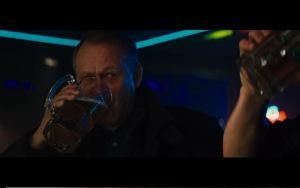
By Branagh’s assessment, one of the most re-edited sequences in the entire film is the ending of Selvig and Thor’s scene in the bar. The ending they went with involves Selvig foolishly engaging in a drinking contest with Thor, as an attempt to establish his superiority and express his protective nature of Jane. We end on Skarsgard flashing a nervous glance at Thor as the two are downing huge beers. Branagh observes, “Of all the scenes in the movie, the ending of this was re-edited maybe 150 times. It took a long getting there, but in the end we went with what it is usually the best option which is the simple one, especially in the hands of two great actors.” Why so difficult? Well, the deleted scenes reveal there was originally much more to it as they continued in the bar for a while longer before spilling out into the streets for some drunken camaraderie and singing of drinking songs.
12. Brush Up On Your Shakespeare…Or Not
In describing the Thor/Jane Romance, Branagh asserts their intent was not to establish a great, legendary romance as that would be far too much too soon. However, the idea was to simply make clear the connection the two shared by the end of the narrative. Of course, in the end they are made quite literal star-crossed lovers. Speaking of which, Branagh again addresses the Shakespeare comparison in the room:
“Many people have asked me about the Shakespeare influence on [Thor and Jane]. I can’t say it was remotely – if it is there it’s only there because Shakespeare nicked some great story ideas and plots points from writers of the past, and we continue to steal ideas from him. One situation was clearly a big hit for him was the idea of putting people together from different worlds, the Romeo & Juliet of it all if you will.”
13. Suck It, Man of Steel – Thor is a Superhero Who Is Also a Good Neighbor
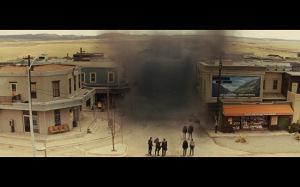
Re-watch Thor’s fight with The Destroyer and you might be surprised to see how completely contained any damage to the town is once Thor has his powers back
There was a considerable amount of hand-wringing over Thor’s battle with The Destroyer, as the challenge presented to them was to have him instantly display his considerable powers as a god and take out a formidable foe. However, he had to do so swiftly because the film still had his battle with Loki coming up. Some wanted far more action from this battle. However, Branagh argues, “A superhero at his best is efficient, he just gets on with it, and is a very good neighbor. Earth is protected, the town is saved.”
Branagh had no way of knowing how interesting those words would seem in comparison to 2013′s Man of Steel. As argued by LovePirate77 at his blog:
“In the first film, Thor finds himself in a small town in New Mexico, facing an enemy on the Main Street of the town just as Superman would in Man of Steel two years later. Instead of flying into battle, however, Thor’s first thought is for the civilians, as he acts not to defeat the enemy but to distract it while they help people escape. This act, along with his willingness to sacrifice his life, is what makes him worthy of Mjolnir and allows him to defeat the machine. Thor only fights once he’s sure that he has saved as many people as possible. This theme is continued in The Avengers.”
14. The First Shot Became the Last
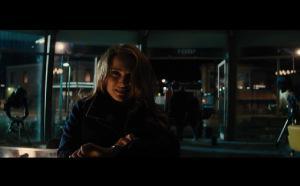
Thor ends in a brilliantly edited sequence in which Heimdell informs Thor that Jane continues searching for him before we cut to Earth to see her doing exactly that, a close-up of her bearing an assured smile cutting back to a shot of Thor smiling in admiration of her fortitude being the last sequence of the film.
However, Branagh reveals that originally the stuff with Jane, Eric, and Darcy on Earth was meant to be the opening shot of the movie. He doesn’t elaborate beyond that. It’s most likely this brief bit was to precede Jane and her team’s now-opening scene in their truck in the desert. When they flipped it to the end of the movie they must have added in the dialog from Eric where he can be heard to reference “SHIELD satellite locations.” If so, ’twas a fantastic decision on their part as it ends the film on exactly the right hopeful tone.
Not all commentaries are created equally, as many are unfortunately giant wastes of time and back-slapping. Others can be entertaining but in no way informative. Branagh’s commentary is not exactly huge on the interesting factoids, such as the ones mentioned in the above list. However, it doesn’t lend itself as well to such discussion because his approach is more professorial, meaning you come away from it wanting to take whatever collegiate course he might someday teach on the art of filmmaking or, more likely, Shakespeare.

